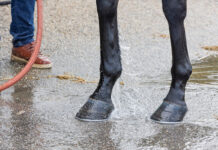If you’re new to horses, it can take some time to learn all the ins-and-outs of routine equine vet care. From vaccinations and hoof care to feed, supplements, and exercise, equine health is a complex subject. Dental care in general—and floating in particular—is one part of the puzzle that new horse people may not have experience with.
“Floating” is the name of the process in which a vet or equine dentist files away sharp edges on a horse’s teeth. Unlike humans, horses’ teeth continue to erupt throughout their lives (leading to the terms “long in the tooth” and “don’t look a gift horse in the mouth.”) But due to the uneven widths of a horse’s upper and lower jaws (along with variations in feed and roughage) the edges of some teeth can wear in an uneven manner, and these edges can become extremely sharp over time, sometimes causing pain in your horse’s mouth, or pain when using certain bits.
How much and how fast these sharp edges develop varies greatly from horse to horse and situation to situation, but it’s common for an average horse to need their teeth floated several times during their lifetime, and perhaps much more often than that. Older horses that have dental issues, such as missing teeth, may also need routine floating as the existing tooth opposite the missing one has nothing to wear against and can thus become very sharp or cause problems.
Your vet will perform a regular oral examination—many vets recommend once a year—to determine if a floating is necessary (as well as to look for any other issues). This includes an examination of the interior your horse’s mouth to check her teeth for sharp edges; your vet will also check your horse’s bite to help identify any uneven grinding surfaces.
If a floating is required, your vet will likely sedate your horse, which will make the job easier on your vet and much less stressful on your horse. The vet will then likely use a mouth speculum to safely hold your horse’s mouth open during the procedure. Next, a rasp is used to file down the uneven edges. Unlike your own teeth, the nerve endings in your horse’s teeth are quite distanced from the surface of the tooth, so the filing does not hurt or cause discomfort to the horse in the way you might imagine. Some vets prefer a handheld rasp, while others use an electric power rasp, but care is taken not to injure the horse’s tongue or the sides of his mouth during the filing in either case. All in all, the floating process probably won’t take more than about fifteen to twenty minutes.
If your horse was sedated for the floating, be sure to withhold feed, forage, or pasture until she’s back to normal, to avoid choke. After that, she’s good to go!






